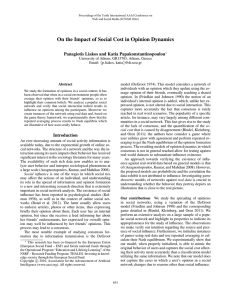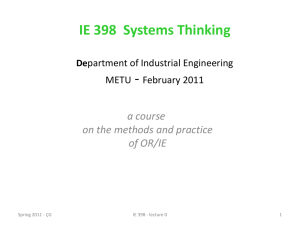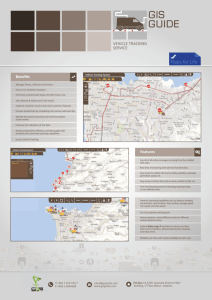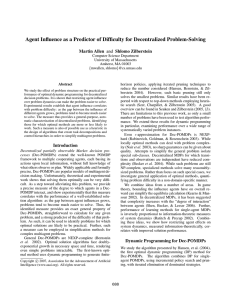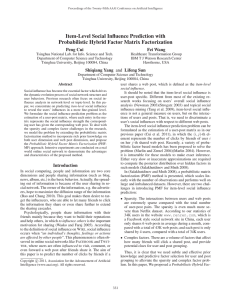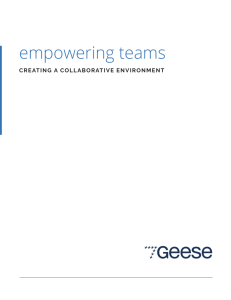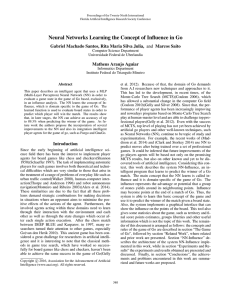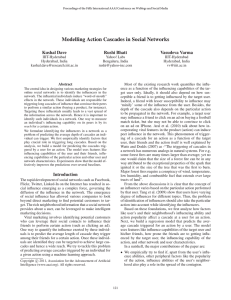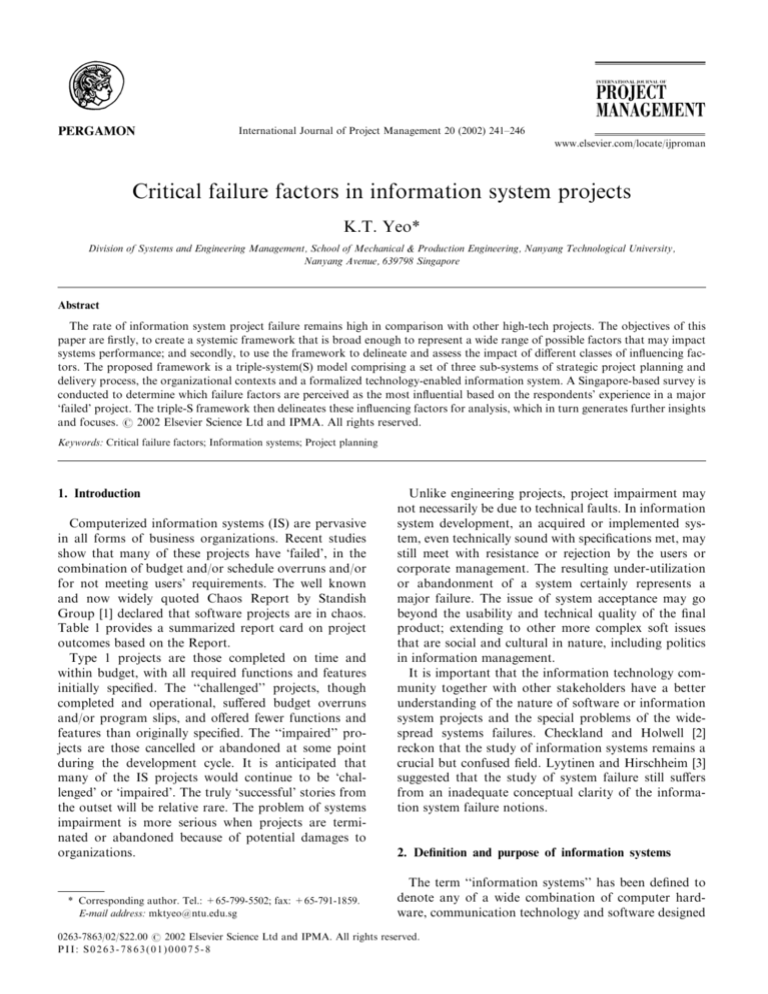
International Journal of Project Management 20 (2002) 241–246
www.elsevier.com/locate/ijproman
Critical failure factors in information system projects
K.T. Yeo*
Division of Systems and Engineering Management, School of Mechanical & Production Engineering, Nanyang Technological University,
Nanyang Avenue, 639798 Singapore
Abstract
The rate of information system project failure remains high in comparison with other high-tech projects. The objectives of this
paper are firstly, to create a systemic framework that is broad enough to represent a wide range of possible factors that may impact
systems performance; and secondly, to use the framework to delineate and assess the impact of different classes of influencing factors. The proposed framework is a triple-system(S) model comprising a set of three sub-systems of strategic project planning and
delivery process, the organizational contexts and a formalized technology-enabled information system. A Singapore-based survey is
conducted to determine which failure factors are perceived as the most influential based on the respondents’ experience in a major
‘failed’ project. The triple-S framework then delineates these influencing factors for analysis, which in turn generates further insights
and focuses. # 2002 Elsevier Science Ltd and IPMA. All rights reserved.
Keywords: Critical failure factors; Information systems; Project planning
1. Introduction
Computerized information systems (IS) are pervasive
in all forms of business organizations. Recent studies
show that many of these projects have ‘failed’, in the
combination of budget and/or schedule overruns and/or
for not meeting users’ requirements. The well known
and now widely quoted Chaos Report by Standish
Group [1] declared that software projects are in chaos.
Table 1 provides a summarized report card on project
outcomes based on the Report.
Type 1 projects are those completed on time and
within budget, with all required functions and features
initially specified. The ‘‘challenged’’ projects, though
completed and operational, suffered budget overruns
and/or program slips, and offered fewer functions and
features than originally specified. The ‘‘impaired’’ projects are those cancelled or abandoned at some point
during the development cycle. It is anticipated that
many of the IS projects would continue to be ‘challenged’ or ‘impaired’. The truly ‘successful’ stories from
the outset will be relative rare. The problem of systems
impairment is more serious when projects are terminated or abandoned because of potential damages to
organizations.
* Corresponding author. Tel.: +65-799-5502; fax: +65-791-1859.
E-mail address: mktyeo@ntu.edu.sg
Unlike engineering projects, project impairment may
not necessarily be due to technical faults. In information
system development, an acquired or implemented system, even technically sound with specifications met, may
still meet with resistance or rejection by the users or
corporate management. The resulting under-utilization
or abandonment of a system certainly represents a
major failure. The issue of system acceptance may go
beyond the usability and technical quality of the final
product; extending to other more complex soft issues
that are social and cultural in nature, including politics
in information management.
It is important that the information technology community together with other stakeholders have a better
understanding of the nature of software or information
system projects and the special problems of the widespread systems failures. Checkland and Holwell [2]
reckon that the study of information systems remains a
crucial but confused field. Lyytinen and Hirschheim [3]
suggested that the study of system failure still suffers
from an inadequate conceptual clarity of the information system failure notions.
2. Definition and purpose of information systems
The term ‘‘information systems’’ has been defined to
denote any of a wide combination of computer hardware, communication technology and software designed
0263-7863/02/$22.00 # 2002 Elsevier Science Ltd and IPMA. All rights reserved.
PII: S0263-7863(01)00075-8
242
K.T. Yeo / International Journal of Project Management 20 (2002) 241–246
to handle information related to one or more business
processes [4]. It serves to coordinate the work of many
different organizational functions, from a back office
administration support, to a company’s strategic management tool. The payroll, sales orders, inventory control
and personnel records systems are some examples of back
office administration support systems. For industries
such as banking, travel and insurance, IS are part of the
operating core of the organization. Implementation of
an information system involves the design, delivery and
use of the software system in the organization.
The subject of IS studies is interdisciplinary, integrating technological disciplines with management and
other disciplines such as psychology and sociology [5].
An information system is user-interfaced and designed
to provide information and information processing
capability to support the strategy, operations, management analysis, and decision-making functions in an
organization. The system uses information technology
(IT), manual procedures, models, and knowledge bases
and databases. Applications may improve operational
efficiency, improve and innovate functions, or restructure business processes. An information system stores,
processes and delivers information relevant to an organization, in such a way that the information is useful to
those who wish to use it, including managers, staff,
customers, and suppliers. An information system may
or may not involve the use of computer systems.
2.1. Basis for the existence of IS
Information has a meaning and use to a particular
recipient in a particular context. It comes from selecting,
summarizing, and presenting data in such a way that it
is useful to the recipient [5]. Information is also defined
as structured data that has a contextual meaning. It
provides the user with the knowledge to make the
necessary decisions. Information systems thus are supposed to inform people (who in the IT context, are
called users or clients) and this is the primary objective
of the existence for information systems [6]. From the
systems thinking view, information systems exist to
serve, help or support people taking action in the real
world [7]. The ‘‘action’’ of the real world could mean
anything from increasing the efficiency of the workforce
to consolidating the resources under the power and
control of one person. The objective of IS existence is
sometimes mixed with politics which are hard to detect.
Table 1
Project resolution by type
Project outcome
Resolution
%
Type 1
Type 2
Type 3
Successful
‘‘Challenged’’
‘‘Impaired’’
16.2%
52.7%
31.1%
3. Notions of IS failure
3.1. Systems failure notions
Lyytinen and Hirschheim [3] define four major
notions or categories of IS failures as follows:
1. Correspondence Failure: When the systems design
objectives are not met, the information system is
considered a failure. It is generally believed that
design goals and requirements can be specified
clearly in advance, and that their achievements can
be accurately measured. Performance measures
mainly based on cost-benefit analysis are
employed for managerial control over the systems
implementation. Correspondence failure, goalseeking in outlook, tends not to recognize that
users may not necessarily accept systems that meet
design objectives and specifications.
2. Process Failure: A process failure occurs when an
IS cannot be developed within an allocated budget, and/or time schedule. There are two likely
outcomes of process failure. Firstly, an outright failure occurs when no workable system
can be produced. Secondly, a more common
outcome is when an information system is
developed with massive overspending in both
cost and time, thus negating the global benefits
of the system. This is a project level failure
attributed to unsatisfactory project management
performance.
3. Interaction Failure: The level of end-user usage of
the information system is suggested as a surrogate
in IS performance measurement. Some related
measures of IS usage include user attitudes and
user satisfaction, the amount of data transferred
or the frequency of use. However, heavy usage
does not necessarily mean high user satisfaction
and improved task performance, and there is little
empirical evidence supporting such a claim. Heavy
systems usage might be a result of legal compulsion, persuasion, or that there are simply no other
alternatives besides using the system.
4. Expectation Failure: The notion of expectation
failure views IS failure as the inability of a system
to meet its stakeholders’ requirements, expectations, or values. Failure, therefore, does not only
involve the system’s inability to meet design (technical) specifications. Expectation failure is perceived as the difference between the actual and
desired situation for the members of a particular
stakeholder group. Unlike the other three notions,
IS failure is considered holistically in this case, as
the views of different stakeholders are taken into
account.
K.T. Yeo / International Journal of Project Management 20 (2002) 241–246
3.2. The drivers of systems performance
The four drivers of system performance are context,
content, process and outcome. They are the driving
forces in initiating a strategic change intervention
through system implementation. The purpose of an
intervention is to specify and effect the content of
change that delivers an outcome that satisfies a strategic
intent. A successful intervention requires a process that
appropriately integrates and reconciles the content and
context in order to achieve the desired outcomes that
fulfill the intent of the strategic initiative [8]. The four
drivers can be coherently integrated and represented as
a framework, as illustrated in Fig. 1, which is in line
with Pettigrew’s [9,10] framework for strategic change
analysis.
243
managing a range of critical failure factors (CFFs) as in:
organizational, financial, technical, human, and political factors, and the interaction among these factors.
The failure factors can be broadly grouped in the organizational and managerial contexts and the actual conduct of an IS development project. Possible failure
factors in the organizational and managerial contexts
include hostile company culture, improper reporting
structure, political pressures, vested interests, influences,
and inappropriate level of management commitment.
Key influencing factors in the conduct of project itself
include pre-occupation with technology in project planning, technology focus over human relations, complexity under-estimated, poor stakeholder management,
poor consultation, design by committee, technical fix for a
management problem, poor competence of project management and project team, and poor selection decisions.
4. Critical factors in IS failure
4.2. Termination failure
4.1. Critical failure factors
Sauer [11] proposes that systems should be considered
as a failure only if there is a development or operation
termination. Based on this criterion, the failure model
takes the natural systems approach, which explains systems behaviour in terms of the goal of survival. This
approach describes the achievement of survival through
acting on the environment so as to obtain necessary
resources (funding) that in turn support the system’s
continued operations. A system is not considered a failure as long as it survives and continues to attract support in resources. The concept first considers
information system as a product of a coalition of stakeholders, which includes project organization, which
assumes the major part of developing, operating, and
maintaining the information systems in question. With
support and commitment from the supporters or promoters, the project organization is able to carry out its
work, ideally with a view to serve the interest of the
supporters. This creates a ‘‘triangle of dependences’’ as
illustrated in Fig. 2. Failure occurs when the level of
dissatisfaction with a system rises to the extent when
there is no longer enough support to sustain it.
Flowers [4] defines an information system as a failure
if any of these following situations occurs: (1) when the
system as a whole does not operate as expected and its
overall performance is sub-optimal; (2) if, on implementation, it does not perform as originally intended or if
it is so user-hostile that it is rejected by users and underutilized; (3) if, the cost of the development exceeds any
benefits the system may bring throughout its useful life;
or (4) due to problems with the complexity of the system,
or the management of the project, the information system development is abandoned before it is completed.
Flowers used large systems failure cases to illustrate the
performance of software system projects as a function of
Fig. 1. Framework of drivers of change.
Fig. 2. Triangle of dependences.
244
K.T. Yeo / International Journal of Project Management 20 (2002) 241–246
Information system failure is indicated by the cessation
of all the work related to the system. Termination failure thus refers to a total abandonment of the project.
5. In search of an integrative framework
To deal with the highly complex field of IS study in
general and systems failures in particular, a soft systemic approach is proposed in search of an integrative
and generic framework for analysis. The systemic
approach simultaneously deals with the logical and cultural/social aspects of systems development and use.
The POM (Processes for Organizational Meanings)
model developed by Checkland and Holwell [2] provides
an important conceptual reference model to make sense
of the studies. The POM model can be represented in
three interacting parts of the main ‘‘discourse’’ processes (Part 1) linking and reconciling the ‘‘organization’’ context (Part 2) with the organized ‘‘information
system’’ (Part 3) with embedded information technology
and business process contents.
Briefly, the POM model represents a social process in
the provision of information system that supports people in organization to take purposeful action in the ful-
fillment of organizational goals. The use of information
system can be thought about as entailing a pair of constituent systems:
1. a system which is ‘‘served’’, denoted as S1, the
primary system, in this paper, and
2. A system that does the ‘‘serving’’, denoted as S2,
which is supporting.
The serving system which is the formalized information system, contains the processing of selected data and
information relevant to people operating in the organization. The twin systems are linked and entailed in the
concept of a purposeful ‘‘information system,’’ which is
more than a computer-based number crunching system.
This paper proposes and gives emphasis to an explicitly expressed third system, the strategic project planning and delivery process system, denoted as Sp, and as
illustrated in Fig. 3. Sp is enabled by a deliberate project
organization that operates in the organizational context
of S1 with the objective to deliver a successful S2.
The strategic project planning and delivery (Sp) system assumes the role and responsibility in overseeing
the whole process of making preparation for, planning,
coordinating and control of the entire strategic formulation, and the associated social and technical
Fig. 3. The triple-S framework for IS planning.
K.T. Yeo / International Journal of Project Management 20 (2002) 241–246
processes in information systems development and
implementation. The process begins from the initiation
of the discourse to the design and acquisition of the
formalized information system that supports the organizational members in their accomplishment of tasks.
Fig. 3 illustrates the proposed ‘‘triple-S’’ framework.
The generic framework is suited for the strategic planning and change management of IS implementation.
The Sp system in the triple-S framework includes and
goes beyond the traditional project management role
and responsibility with pre-occupation with the ‘‘how’’
and ‘‘what’’. The traditional pre-occupation is mainly
concerned with technical and business/work process
design contents, which characterize the S2 system. The
project management must now also be involved in
creating the big picture and in thinking about strategic
formulation, in making a business case and managing
the resulting change processes.
The change processes focus on the thorough process
analysis involving the discourses in search of meaning,
purposes, accommodation and intents. The IS project
manager when dealing with the Sp system, is likely to
use the soft systemic approach to deal with the many illstructured and messy problems to be encountered in the
system development process. The discourse processes
can be highly political in nature. The traditional project
management largely based on ‘‘hard’’ systems engineering approach will be found to be inadequate and incapable of coping with many of the ill defined ‘soft’
problem situations. The Sp system, which is under the
influence of information system project managers, with
the support and commitment of top management, must
245
ensure the proper coupling of the content-driven ‘‘serving’’ system and the context-driven ‘‘served’’ system in
the change processes.
6. Delineating failure factors
6.1. Spheres and issues of influence
The identification and delineation of information system failure factors can be a highly complex task. The
integrative triple-S framework is used as a basis to
group and analyze a multitude of possible factors that
may cause an information system to fail. The triple-S
framework can be perceived as three spheres of influence
(SOI) over project outcomes. The three SOI are further
operationalised into 10 main issues of influence (IOI), as
shown in the Table 2. These issues are in turn defined by
a list of failure factors filtered out from an in-depth literature review on information system and system failure
studies.
6.2. Failure factors analysis
Failure factors analysis is based on 92 usable returns
from a Singapore-based questionnaire survey conducted
in November 2000. The respondents’ responses were
based on their experience on one IS project which had
been challenged or impaired. The following present a
partial result on the key influencing factors, which may
have contributed to the project failures. These factors
can be evaluated under 10 different issues of influence
Table 2
Defining ‘Issues of influence’ under the three ‘Spheres of influence’
Sp Process driven issues
S1 Context driven issues
S2 Content driven issues
Related to
(1) Business planning
(2) Project planning
(3) Project management and control
Related to
(4) Corporate culture
(5) Corporate management
(6) Users
(7) Politics
Related to
(8) Information technology
(9) Business process and system design
(10) IT/IS professional and knowledge sources
Table 3
Top 5 failure factors under Sp, S1 and S2
Rank
Sp Process driven issues
S1 Context driven issues
S2 Content driven issues
1
Underestimate of timeline
2
Weak definitions of requirements
and scope
Inadequate project risk analysis
Incorrect assumptions regarding
risk analysis
Ambiguous business needs and
unclear vision
Lack user involvement and inputs
from the onset
Top down management style
Consultant/vendor underestimated the
project scope and complexity
Incomplete specifications when
project started
Inappropriate choice of software
Changes in design specifications late
the project
Involve high degree of customisation
in application
3
4
5
Poor internal communication
Absence of an influential champion
and change agent
Reactive and not pro-active in dealing
with problems
246
K.T. Yeo / International Journal of Project Management 20 (2002) 241–246
Table 4
Relative ranking of the Issues of Influence
Rank
Issues
Symbol
Mean
1
2
3
4
5
6
7
8
9
10
Project planning
Corporate culture
Project management and control
Business process and system design
IT/IS professionals
Information technology
Users
Coporate management
Politics
Business planning
PP
CC
PMC
BPSD
IT/ISP
IT
U
CM
P
BP
2.85
2.77
2.74
2.65
2.64
2.59
2.58
2.53
2.50
2.50
(IOI) and the three dominant spheres of influence (SOI)
as defined in the triple-S framework. The statistical
analysis takes into consideration extreme and diverse
views of the respondents (rating 1 through 5) and the
mean score is used as indicative of the relative importance of the factors.
About half of the first one-third of the failure factors
listed belong to the Sp sphere influence, highlighting a
significant proportion of problems information system
projects faced are related to project planning issues.
Table 3 lists the top five factors categorized under Sp,
S1 and S2 sphere of influence respectively.
Table 4 presents the relative mean scores under the 10
different issues of influence (IOI). Project Planning (PP),
Project Management and Control (PMC) and Corporate Culture (CC) have higher scores, which are indicative of their relative significance.
7. Conclusions
The IT/IS industry and community continue to be
plagued with extensive problems of systems failure. The
field of IT/IS project management remains in ‘‘chaos’’.
The gap between theory and practice in IS studies, particular failure studies, remains. The study presented in
this paper is another attempt trying to make sense of the
somewhat ‘confused’ field of IS studies in general and IS
project management in particular. The emphasis is on
adopting a systemic approach in IS project planning
and delivery process. The tentative outcome of this
study is the proposal of a triple-system(S) framework
built on the basis of soft systemic thinking. There is a
high degree of congruence and consistency among the
previous IS studies and the soft systemic thinking. The
idea of coupling the systems ‘‘serving’’ and ‘‘served’’ in
a master–servant relationship is a very useful and worthy one and should be considered indepth. The paper
highlights the importance of the third system, Sp, as an
explicitly expressed process- and outcome-driven entity
that ensures the integration and coupling of the served
and serving systems.
Acknowledgements
The author would like to thank Thomas Lim CK, his
research student, in the conduct of the survey.
References
[1] The Standish Group. The CHAOS Report (1995), 1995. http://
www.standishgroup.com/chaos.html.
[2] Checkland P, Holwell S. Information, systems and information
systems. Chichester, UK: John Wiley, 1998.
[3] Lyytinen K, Hirschheim R. Information failures—a survey and
classification of the empirical literature. Oxford Surveys in
Information Technology 1987;4:257–309.
[4] Flowers S. Software failure: management failure. Chichester,
UK: John Wiley, 1996.
[5] Avison DE, Fitzgerald G. Information system development:
methodologies, technologies, & tools. 2nd ed. London: McGraw
Hill, 1995.
[6] Bell S, Wood-Harper X. Rapid information systems development. 2nd ed . London: McGraw Hill, 1998.
[7] Checkland P, Scholes J. Soft systems methodology in action.
Chichester, UK: John Wiley, 1990.
[8] Ward J, Elvin R. A new framework for managing IT-enable
business change. Information System Journal 1999;9:197–221.
[9] Pettigrew AM, editor. The management of strategic change.
Oxford, UK: Basil Blackwell, 1987 (Chapter 1).
[10] Pettigrew A, Whipp R. Managing change for competitive success.
Oxford, UK: Blackwell, 1993 (Chapter 1).
[11] Sauer C. Why information systems fail: a case study approach,
information systems series. Henley-on-Thames, UK: Alfred Waller, 1993.


